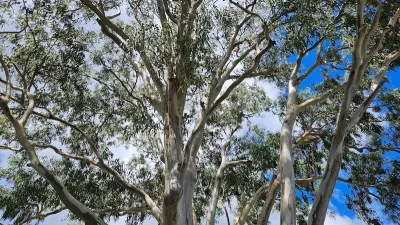Louis Sagahun explores the unexpected benefits of trading 5,000 square feet of grass and pavement for native plants at a Los Angeles elementary school.
Located deep in the concrete jungle just west of Downtown Los Angeles, Leo Politi Elementary School has witnessed a transformation in student learning and engagement. Like so many inner-city schools, it suffered from low test scores and a dreary landscape – that is, until a grant from the U.S. Fish and Wildlife Service brought a natural habitat onto the schoolyard.
After crews tore up 5,000 square feet of blacktop and replaced it with native flora, bugs shortly followed. After bugs came birds, and after birds came children. Marveled by the natural processes taking place on the playground, the children found a real-life experience against which to anchor their scientific curiosity, leading the school to an astronomical improvement on test scores in science.
Whereas three years ago, only one in eleven students tested "proficient" in science (and none ranked "advanced"), now more than half perform at those levels.
"Questions about why some birds flocked to one plant and not another led to discussions about soil composition and water cycles, weather patterns and seasons, avian migration and the tilt of the Earth in its orbit around the sun," said principal Brad Rumble.
And as lead arts and humanities teacher Robert Jeffers explains, the benefits extend beyond scientific understanding. The habitat has "instilled a profound sense of responsibility and awareness of nature," Jeffers said. "Now these kids can tell the difference between a crow and a raven, which requires cognitive skills of understanding subtleties and nuances important throughout life."
FULL STORY: At an urban L.A. school, nature grows — and test scores too

Alabama: Trump Terminates Settlements for Black Communities Harmed By Raw Sewage
Trump deemed the landmark civil rights agreement “illegal DEI and environmental justice policy.”

Planetizen Federal Action Tracker
A weekly monitor of how Trump’s orders and actions are impacting planners and planning in America.

The 120 Year Old Tiny Home Villages That Sheltered San Francisco’s Earthquake Refugees
More than a century ago, San Francisco mobilized to house thousands of residents displaced by the 1906 earthquake. Could their strategy offer a model for the present?

LA’s Tree Emergency Goes Beyond Vandalism
After a vandal destroyed dozens of downtown LA trees, Mayor Karen Bass vowed to replace them. Days later, she slashed the city’s tree budget.

Sacramento Leads Nation With Bus-Mounted Bike Lane Enforcement Cameras
The city is the first to use its bus-mounted traffic enforcement system to cite drivers who park or drive in bike lanes.

Seattle Voters Approve Social Housing Referendum
Voters approved a corporate tax to fund the city’s housing authority despite an opposition campaign funded by Amazon and Microsoft.
Urban Design for Planners 1: Software Tools
This six-course series explores essential urban design concepts using open source software and equips planners with the tools they need to participate fully in the urban design process.
Planning for Universal Design
Learn the tools for implementing Universal Design in planning regulations.
Ada County Highway District
Clanton & Associates, Inc.
Jessamine County Fiscal Court
Institute for Housing and Urban Development Studies (IHS)
City of Grandview
Harvard GSD Executive Education
Toledo-Lucas County Plan Commissions
Salt Lake City
NYU Wagner Graduate School of Public Service





























